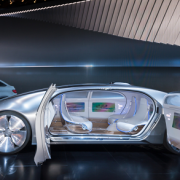Cities Should Start Testing Autonomous Transit: Planner
Burney Simpson
Cities should begin testing Level 5 autonomous vehicles now in last mile/first mile transit applications to stay ahead of the coming changes brought by driverless technology, according to Grush Niles Associates, a transportation planning consultant.
Implementing Level 5 transit on an incremental, application-by-application basis will help it to expand and spread as demand grows, the consultants write in “Getting Past the Hype” in the new Thinking Highways, North America.
Level 5 vehicles, defined as fully autonomous and capable of operating without a driver, have been successfully used in several cities in Europe during the CityMobil2 project. Cities include La Rochelle, France; Lausanne, Switzerland; near Helsinki, Finland; and Trikala, Greece.
The providers include EasyMile, Navya, RoboSoft, and 2getthere. Specs vary but a typical vehicle is electric-powered, has a range of 50 miles, and can carry 12 passengers. They have onboard navigation systems and obstacle detection systems, and are monitored from a control room.
EasyMile is scheduled to begin operations at a business park this year in California (“Driverless Shuttle Gives Momentum to GoMentum Station“).
“These vehicles run in controlled loops through residential areas to a work area,” says Bern Grush. “Level 5 (vehicles) are here for constrained, simple transit.”
TRANSIT LEAP

Grush calls his approach Transit Leap, where “public-use, robotic, shared-mobility applications” will encourage consumers to shift to transit and away from single-owner cars.
His goal is a transportation system where 40 percent of trips are done on public transit, 40 percent are provided by a private transit owner (Uber, for example), and 20 percent in a privately-owned car.
In comparison, today about 90 percent of trips are done in a privately-owned car, with the remaining 10 percent delivered either by public transit or a private transit provider like Uber or a cab company, says Grush.
Grush’s goal contrasts with the concept seen in the futuristic driverless cars showcased by Mercedes and Volvo at events like CES 2016. These still have a steering wheel and play on the desire by many consumers to own a car, he says.
“If they have a steering wheel, it’s designed to be a (consumer) vehicle,” said Grush. “If not, then it’s transit.”
The future vehicles from the auto OEMs generally have an autonomous technology of Level 3, or conditional automation. Drivers must take the wheel on congested, complicated city roads but the car will run on its own for highway driving.
These vehicles, possibly widely available by 2025, encourage the owner to live further from work, says Grush. That will lead to more car ownership, more congestion, and increased public demand for more large highways.
That’s not the way to go, as Grush Niles explains on its End of Driving website:
“(T)here is a risk to municipalities and their populations to be overwhelmed by a new wave of private, low-occupancy automobile dominance that collectively detracts from community livability, adds to sprawl, increases infrastructure costs, and degrades the environment.”
HYPE CYCLE
While the move to autonomous vehicles seems inevitable, municipal planners still have some time to experiment with the concept. That is, if technology consultant Gartner is right with its Emerging Technologies Hype Cycle.
Last July Gartner put autonomous vehicles at the very top of its Peak of Inflated Expectations in the Hype Cycle. That was when one expert after another said the technology would end hunger, bring peace, and reunite the Ramones.
 The next step in the Hype Cycle is for driverless to enter the Trough of Disillusionment, possibly after an accident or cybersecurity breach that shows its fallibility.
The next step in the Hype Cycle is for driverless to enter the Trough of Disillusionment, possibly after an accident or cybersecurity breach that shows its fallibility.
However, the technology will comeback, and go on to reach a Plateau of Productivity when it is working efficiently and is widely accepted.
That’s why planners should begin testing CityMobil2-style vehicles now to work out the bugs, says Grush.
“Municipalities need the experience. This is still a few years away,” says Grush. “The Trough gives us the opportunity.”








 Stan Young is a research scientist with the
Stan Young is a research scientist with the  With the onset of fully connected and automated vehicles (and the services they enable), how we access our jobs and recreation will likely drastically change. We are seeing the front edge of this wave of change in services like Uber, Lyft, car-sharing, and ride-sharing. These have all been enabled by the information revolution. Coupled with the automation revolution, well … hang on for an interesting ride.
With the onset of fully connected and automated vehicles (and the services they enable), how we access our jobs and recreation will likely drastically change. We are seeing the front edge of this wave of change in services like Uber, Lyft, car-sharing, and ride-sharing. These have all been enabled by the information revolution. Coupled with the automation revolution, well … hang on for an interesting ride. How does advanced transit overlap with autonomous and connected vehicles? Are these transit vehicles driverless?
How does advanced transit overlap with autonomous and connected vehicles? Are these transit vehicles driverless? Reducing the use of fossil fuels and shifting to sustainable mobility is an important part of advanced transit theory. How do you convince transit vehicle OEMs to build electric powered driverless vehicles?
Reducing the use of fossil fuels and shifting to sustainable mobility is an important part of advanced transit theory. How do you convince transit vehicle OEMs to build electric powered driverless vehicles?


